Bede HE 2.12.3 articulated
Annotations
Properties
Bede HE 2.1.28 articulated
Annotations
Properties
Bede HE 2.1.16 articulated
Annotations
Properties
Bede HE Praef. 18 articulated
Annotations
Properties
Bede HE Praef. 17 articulated
Annotations
Properties
Bede HE Praef. 16 articulated
Annotations
Properties
Church of St. Mary the Virgin (interior)
Annotations
The interior of the Anglo-Saxon (late 8th-early 9th century) church of St. Mary the Virgin, Deerhurst, Gloucestershire.
The Priory of St. Mary the Virgin in Deerhurst was founded sometime before 804, and was an important foundation in the kingdom of the Hwicce. One of Deerhurst's monks, St. Alphege, became the Archbishop of Canterbury, and was martyred by the Danes in 1012.
This photograph of the interior of the surviving church shows the high Anglo-Saxon double windows in the church tower. The arched windows and lower arches in the nave are of a later date; like most medieval churches, it ws altered and renovated numerous times over the centuries. The church contains several Anglo-Saxon carvings, and the best-preserved Anglo-Saxon baptismal font in England. It also contains later medieval stained glass and brasses.
Reference:
Friends of Deerhurst Church. "A Brief History of Deerhurst and Its Churches."
Properties
Sutton Hoo Sceptre (Replica)
Annotations
This object, found in the early 7th-century Sutton Hoo ship burial, is thought to be either a whetstone or a sceptre, perhaps similar to the thuuf mentioned at the end of HE 2.16. Colgrave-Mynors notes: "An object found at Sutton Hoo in the burial ship ... is supposed by some to be a royal standard of some kind ... Bede probably got the word tufa from Vegetius [Dē Re Militārī 3.5]. The Old English word thuf (tuft of feathers or foliage) with which he equated it, suggests that the standard was bushy or covered with foliage..." (p. 192, n. 3).
See:
"Whetstone from the Sutton Hoo ship burial." British Museum.
"Whetstone or Sceptre?" Medieval Histories (7 November 2013). Web.

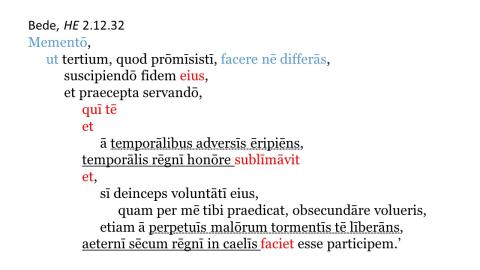
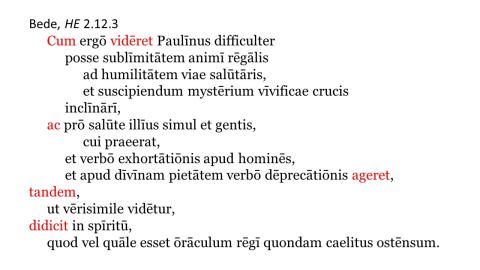
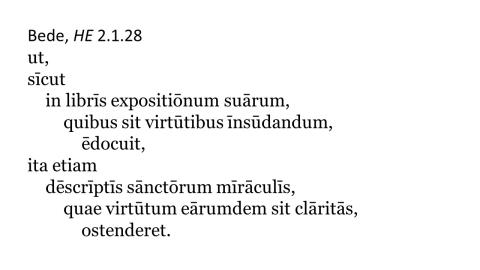
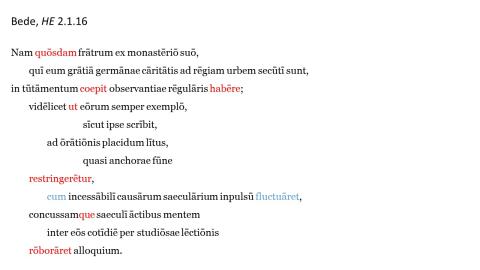
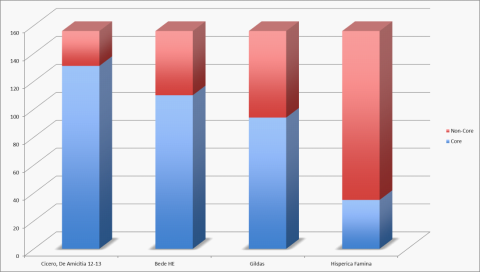
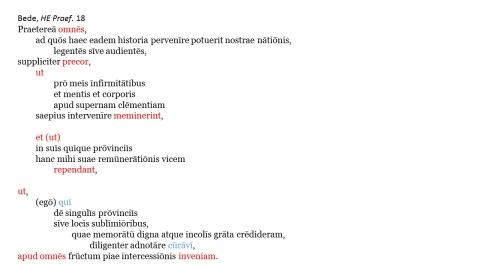
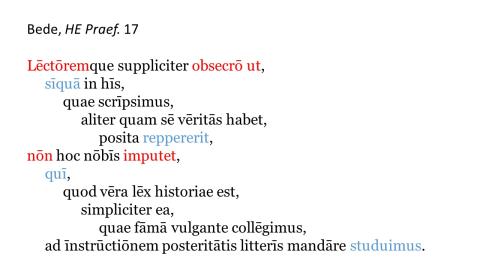
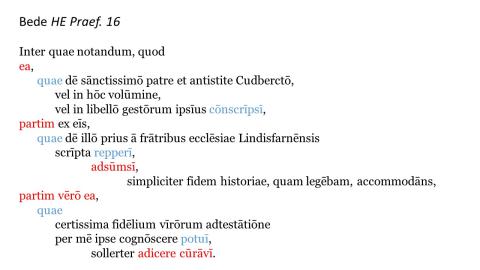


The graph shows the ratios of DCC Core and Non-Core vocabulary in the first section (156 words) of Bede’s Praefatio and in a 156-word selection from Cicero’s Dē Amicitiā (1st c. BCE), Gildas’s Dē Excidiō et Conquestū Britanniae (6th c. CE) and the Hisperica Famina (7th c. CE). In the case of the Hisperica, the comparison is somewhat artificial because the Hisperica is in verse, and likely aims at a parodic effect with its deliberately obscure vocabulary (Ó Cróinín 1995, 179).
In the passage from Cicero, 84% of the vocabulary is in the Core; in Bede, 71%; in Gildas, 60%; and in the Hisperica Famina, 22%. Of the Non-Core vocabulary in Bede, several of the words (such as transcribō and transmittō) are compounded forms of Core vocabulary words.
The largest class of non-Core vocabulary words in Bede are Christian Latin vocabulary words like abbas (abbot), episcopus (bishop), monasterium (monastery), and rēgulāris (governed by a monastic rule). Most words in Bede’s Historia Ecclesiastica can be found in standard Latin dictionaries such as the Oxford Latin Dictionary and Lewis and Short. But certain words that appear in these dictionaries will have different, specifically Christian connotations in Bede. Most of these can be found in the Dictionary of Medieval Latin from British Sources (“DMLBS”) and the Glossarium mediae et infimae latinitatis (“DuCange”), both of which are included on Logeion.